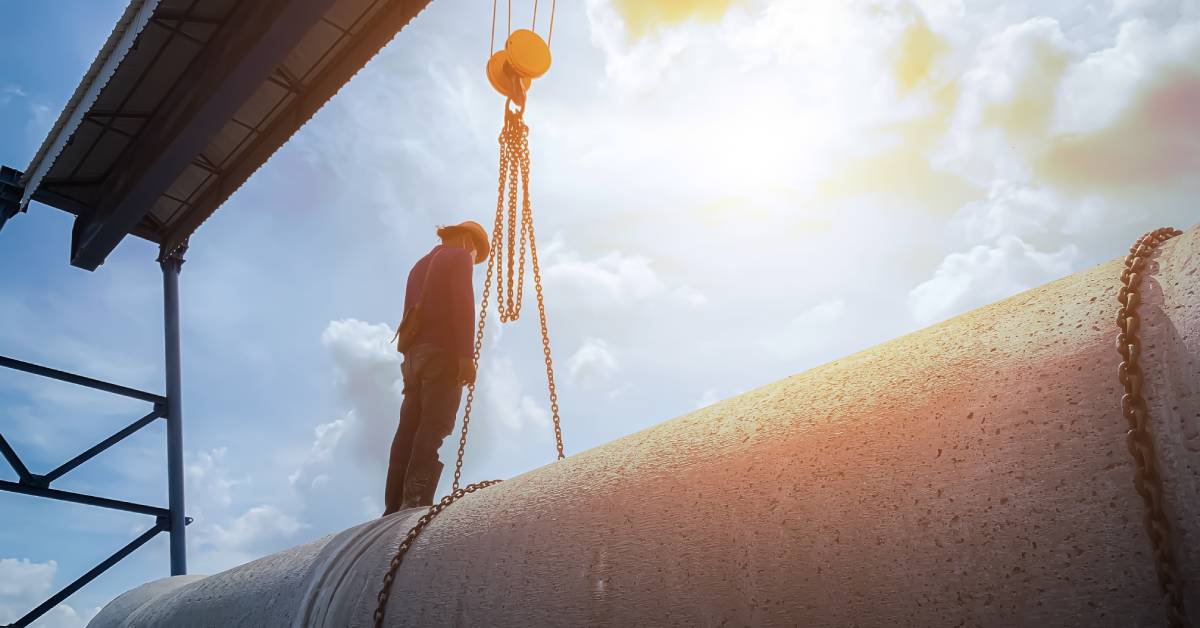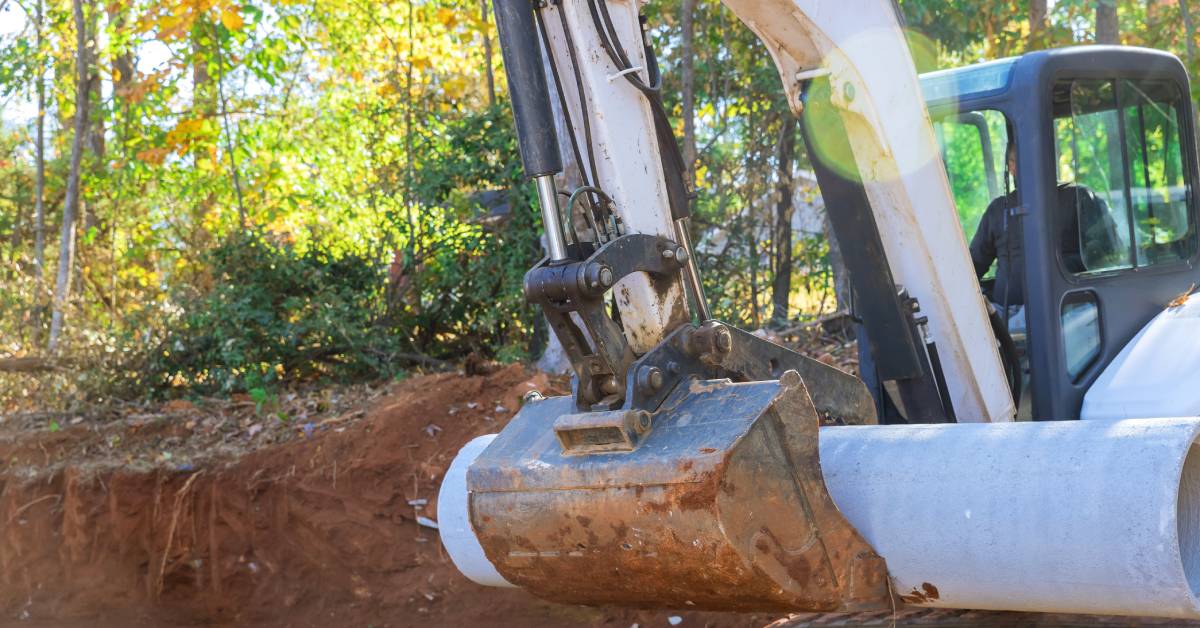Pros and Cons of Different Types of Concrete Pipe Lifters
Whether you’re working on gas pipelines, sewer systems, or other municipality work, moving massive pipes on your own simply isn’t an option. Concrete pipe lifters play a crucial role in such tasks, streamlining operations, reducing labor costs, and enhancing workplace safety.
As essential tools for moving and placing pipes, these lifters come in various types, each with its own set of advantages and drawbacks. In this guide, we’ll dive into the pros and cons of different concrete pipe lifters to help you make an informed decision for your next project.
Pipe Tongs
Pipe tongs are a popular choice for lifting concrete pipes due to their simplicity and reliability. Their gripping arms can easily latch onto the pipe, making them particularly useful for pipes of varying diameters.
One major advantage of pipe tongs is their ease of use. Operators often find them straightforward to handle, which can speed up the learning curve and reduce downtime. Additionally, pipe tongs are typically robust and durable, meaning they’re less likely to suffer from frequent breakdowns, ensuring continuous operation on your project site. They also require minimal maintenance, further cutting down on long-term operational costs.
However, there are some disadvantages to consider. The grip of pipe tongs can sometimes damage the pipe, especially if operators don’t adjust them correctly. This risk of damage makes them less suitable for fragile or specially treated pipes. Also, they might not offer the same level of precision or security as other types of lifters, particularly for large or heavy pipes.

Spade-Type Pipe Lifters
Spade-type pipe lifters are another versatile option for handling concrete pipes. These lifters have flat, spade-like ends that slide under the pipe, providing a secure hold from underneath.
A key advantage of spade-type lifters is their suitability for a wide range of pipe sizes and conditions, making them an excellent all-round choice for various projects. They offer a non-intrusive grip that significantly reduces the risk of damaging the surface of the pipes, which is especially important for fragile or coated pipes.
On the flip side, there are a few drawbacks to consider. The setup and adjustment process for spade-type lifters can be more complex and time-consuming compared to other lifters, potentially leading to increased downtime. Additionally, while their grip is gentle on the pipes, it may not be as secure as some other types of lifters, posing a higher risk of slippage during lifting operations. This makes them less ideal for extremely heavy or large pipes where an extra-secure grip is paramount.
Keyhole Pipe Lifters
Keyhole pipe lifters offer a unique approach to lifting concrete pipes, utilizing a pin and keyhole mechanism to secure the pipe. Their design allows for quick attachment and release, which can significantly speed up operations on a busy worksite. This mechanism also ensures a very secure hold, reducing the risk of slippage and enhancing safety during lifting tasks.
On the positive side, keyhole pipe lifters are generally easier to operate, requiring less manual adjustment compared to other types, which can help reduce labor costs and training time. Their robust and straightforward design means they typically require less maintenance, making them a cost-effective option in the long run. Additionally, their secure hold minimizes pipe damage, making them suitable for a wide range of pipes, including those with delicate coatings.
However, keyhole pipe lifters are not without their drawbacks. One significant disadvantage is that they require the pipe to have a pre-drilled keyhole, which can add an extra step to your project preparation and potentially increase costs. This limitation also means they are not as versatile in handling different pipe types or sizes, particularly those without keyholes. They’re also not as strong as some other lifter types, making them less ideal for extremely heavy or large pipes.

Pipe Clamps
Pipe clamps are renowned for their precision and strong grasp, making them an indispensable tool in the array of concrete pipe lifters. These lifters utilize a clamping mechanism that firmly secures the pipe, providing an extremely stable and secure hold. This makes pipe clamps particularly advantageous for jobs involving very large and heavy pipes, where security and precision are non-negotiable.
One major benefit of using pipe clamps is their enhanced safety. The robust clamping action minimizes the risk of slippage during lifting, which significantly reduces the chances of accidents on the worksite. Additionally, pipe clamps are versatile, and operators can adjust them to fit a range of pipe sizes. This adaptability can be a game-changer when working with pipes of varying diameters, ensuring you have a reliable tool regardless of the pipe size.
However, the strong grip of pipe clamps, while advantageous for security, can sometimes lead to the risk of pinching or damaging the pipe. Moreover, the initial setup and adjustment of pipe clamps can be more involved than simpler lifters, leading to an increase in preparation time. Additionally, their precise nature demands more frequent maintenance to ensure they remain in optimal working condition, which could add to the overall operational costs.
Pipe Hooks
Pipe hooks offer a straightforward yet highly effective solution for lifting concrete pipes. These lifters have sturdy hooks to latch onto the ends of the lifting points of the pipe, providing a simple and fast way to move pipes around a job site.
One of the most appealing advantages of pipe hooks is their ease of use. Their simple design allows for quick attachment and release, significantly expediting the lifting and placement process. This efficiency can lead to considerable time savings and reduce the overall duration of projects.
Despite their simplicity and effectiveness, pipe hooks do have some drawbacks. The primary concern is the potential for damage to the pipe, especially if the hooks are not positioned correctly or if the pipe material is particularly delicate. This risk makes pipe hooks less suitable for pipes with special coatings or fragile surfaces. Furthermore, while pipe hooks offer speed and convenience, they may not provide the same level of security and stability as other lifter types, such as pipe clamps. This could pose a higher risk during the transportation of very large or exceptionally heavy pipes, where a more secure grip is essential.
As we’ve explored, each type of concrete pipe lifter—from pipe tongs and spade-type lifters to pipe clamps, keyhole lifters, and pipe hooks—offers its own set of pros and cons. The decision ultimately hinges on the specific demands of your task, such as the size and delicacy of the pipes you’re handling, the need for precision, and the importance of minimizing downtime.
If lifting large, heavy pipe work is part of your daily work, then a pipe lifting clamp is the best choice for your operations. At Kenco Corporation, we offer easy-to-operate, state-of-the-art clamps that will help you complete your project quickly, safely, and without breaking the bank.




Leave a Reply
Want to join the discussion?Feel free to contribute!